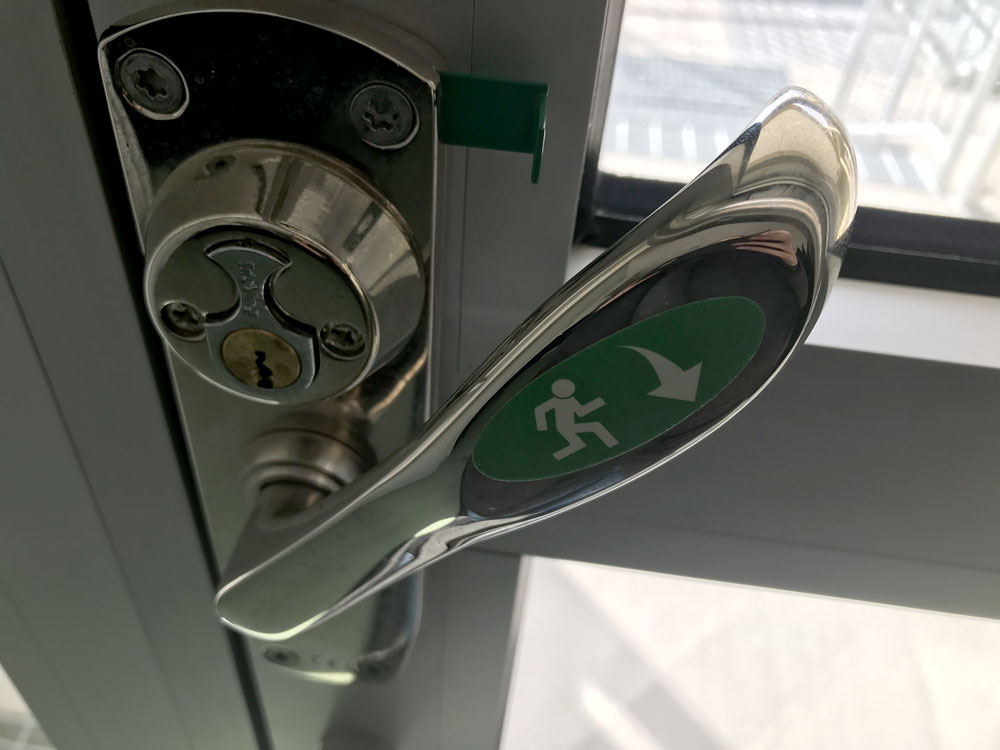Thus, the nursing home can reduce the risk of residents with dementia getting lost without locking them up
This article is written from Swedish perspectives. Hopefully, it can inspire interested people from other countries.
Many people living in elderly homes have dementia and risk getting lost if they leave the elderly home. The staff at the elderly home need to have a good working method to oversee the residents. It is important to find a good working method so that the residents do not get lost. Creating a safe environment for residents with dementia is an important part of the care at the elderly home. However, it is a challenge to balance the resident's freedom with the need for safety, especially in terms of the risk of a person with dementia wandering off and getting lost. In Sweden, it is not allowed to lock people in dementia homes, which requires other methods to ensure safety without infringing on freedom.
 Foto-Trullsa_Mostphotos-webb
Foto-Trullsa_Mostphotos-webbLocked doors
Locked doors in dementia care homes are a sensitive issue. Despite the fact that, according to the National Board of Health and Welfare, it is not permitted to restrict the freedom of movement of the elderly with code locks or locked doors, many people with dementia live in wards they cannot leave on their own. However, for people with dementia, a locked door can create anxiety. People disappearing from the home also creates anxiety for both staff and relatives. The fact that the front door of the house is locked is seen more as a normal occurrence. However, it must not be impossible or very difficult to leave. The constitution contains a general protection against deprivation of liberty that is not decided with the support of another law.
Managing residents who want to go out
As a staff member, situations arise where work is conducted in a gray area. No one has yet been prosecuted for unlawful deprivation of liberty, but operations have been criticized by the National Board of Health and Welfare and the Health and Social Care Inspectorate. However, there have been cases where a resident has been locked in their apartment. There can also arise self-defense-like situations where you dare not let a severely demented person out of the residence in the middle of winter. Often it is also difficult to let a staff member go with the resident so the nurse tries to postpone in time or get the resident onto other thoughts.
During the night, emergencies can arise where the nurse has to leave her unit to help a colleague care for a resident or lift someone who has fallen on the floor. A locked unit can then be left empty. This has led to criticism from the National Board of Health and Welfare and the Health and Social Care Inspectorate on several occasions.
Attempts are being made to find solutions. Some residences only have one entrance. Placing activities and having staff who keep an eye on the front door represents an opportunity to have supervision without having to have locked doors within the house.
Alternatives to locked doors
At Hälleborg's elderly care in Västerås, there are no locked doors. Instead, elderly people with dementia, who are judged to need it, carry a transmitter that alarms the staff's mobiles if they leave the department. When the door is locked, it is not uncommon for a resident to stand at the door and want to get out. This can create discomfort for visitors, so they do not want to get into a dispute with the resident.
With open doors, this problem ceases. There are larger areas for the resident to move on and more residents to socialize with. With decoration and design of the premises, attention can be directed towards the garden instead of the main entrance of the building. The alarms can be set based on the resident's conditions and some can roam freely in the house and garden. The alarm then goes off if they leave the property entirely.
Reduced anxiety
Studies also show that unlocked doors and digital technology used correctly can reduce the need to use anxiety-reducing drugs. The staff also do not need to spend a lot of time escorting back elderly people who have left the unit. Technology can be a support in caring for our elderly, but never replace calming hands.
The starting point must be to evaluate the business you have and work from the resources that are available on the business. Otherwise, it is easy to get stuck in that there are no "means" to carry out various measures. There is competent staff in the operations who have imagination and interest in designing the "right environment" for our elderly with simple measures. It is rarely about economy. Many times the operation can start directly with good measures that make a difference. Leadership and clear goals with the operation are crucial in getting results.
The starting point must be to see what prevents or provides opportunities for daily activities, and to provide the right support so that the environment can be more easily understood and interpreted by the demented person.
Architecture and decoration
Long corridors can cause a wandering behavior. Is it possible to create interruptions so that attention is captured or curiosity arises to stop and do something else. We know that yellow and green colors create calm and harmony. Working with colors to create comfort and a homely understandable recognizable environment creates less worry and anxiety.
A properly designed kitchen with the opportunity for scent and taste experiences can probably stimulate old habits such as baking and cooking. For many people with dementia, it can be difficult to take the initiative for activity therefore things must be visible, ex. cups in the kitchen that need to be "washed", a watering can on the table, or a broom that "stands in some corner".
Create a safe and adapted environment
Design of the environment: A well-thought-out physical environment can help reduce the risk of a resident getting lost. By creating clear guides with color-coded doors and signs, residents can more easily orient themselves. The use of visual cues such as images or symbols can facilitate those who have difficulty interpreting text. Having clear boundaries and natural obstacles, like plantings and gardens, can help guide the residents without infringing on their freedom.
Security through gardens: Constructing a secure fenced garden where the residents can move freely creates both security and freedom. A secure garden provides the opportunity for outdoor stays without risking someone leaving the residence and getting lost. The garden can be furnished with paths and benches that encourage exercise and social interaction in a safe environment.
Technological solutions for increased security
GPS tracking and alarms: Technology can play a vital role in preventing a resident with dementia from getting lost. Using GPS tracking in the form of bracelets or alarms that are activated when a resident leaves a safe zone can help staff quickly intervene if someone should get lost. These solutions give the residents freedom to move without feeling monitored, while the staff can act quickly when needed.
Alarm systems at exits: Special alarm systems that are activated when a resident tries to leave an exit can be installed at the elderly residence. This can be in the form of discreet alarm mats at the doors or sensors that sense when someone approaches an exit. The staff then receives a warning and can intervene before the person has a chance to leave the residence.
Person-centered care and supervision
Know the resident's needs: To reduce the risk of a resident getting lost, it is important that the staff is familiar with the individual needs and behaviors of each resident with dementia. People with dementia often become restless or feel a need to "go home". By understanding these feelings, staff can prevent these situations by offering supportive activities and conversations.
Activities to reduce restlessness: Restlessness is a common reason why people with dementia start wandering. Creating meaningful and engaging activities can reduce the risk of residents feeling the need to leave the residence. Walks with staff, gardening, or other physical activities can reduce the need to wander on their own.
Close cooperation with relatives
Dialogue with relatives: Close cooperation with the residents' relatives is crucial to understanding the resident's habits and previous behavior patterns. By communicating regularly with the relatives, staff can get important information about what can trigger a wandering behavior and how to best handle it. Relatives can also be involved in discussing the use of technological aids such as GPS alarms or special monitoring systems.
Individualized plan: Together with relatives and responsible staff, an individualized plan can be created for each resident, taking into account the person's needs and behavior patterns. The plan should be regularly reviewed and adjusted if the resident's condition changes.
Education and awareness among staff
Increased awareness of dementia diseases: Educating staff to understand the cognitive and behavioral challenges that dementia diseases entail is a fundamental part of the work. When staff have knowledge of why a resident may feel the need to leave the residence or get lost, they can more easily identify early signs of restlessness and act preventively.
Routines for supervision and safety: Regular routines for supervision of the residents should be in place. Staff should keep an eye on those who have a higher risk of getting lost and be extra attentive at times of the day when it is common for a resident to start wandering, for example in the evening. Regular walks and physical activity can also be part of the care to reduce the need to go on their own.
Reducing the risk of a resident with dementia wandering off and getting lost is an important part of the safety work at the elderly residence. By creating a safe and adapted environment, using technological solutions, working with person-centered care, and involving relatives, the elderly residence can reduce the risk of this happening. Training of staff and clear routines for supervision and safety are also crucial in creating a safe but free environment for the residents.
Reflection questions - locked doors
Care personnel:
- Do you have situations where your residents can feel locked in?
- Do you have good routines to handle it?
Manager, nurse, occupational therapist, and physiotherapist:
- What can you do to increase openness in your residence?
- Do situations arise where staff end up in self-defense situations with residents who want out?
- Do you have good routines to avoid residents feeling locked in?
Residents and relatives:
- Do you feel that the elderly residence works well with these issues?
Erland Olsson
Specialist nurse
Sofrosyne - Better care every day
Quality in elderly care

Aktuellt i media
-
2025-12-18 04:00
16 Sjukdom och död
Survivor conversations - an important element in working with next of kin
info Bild från Summer Stock
Bild från Summer Stock - 2025-12-15 04:00 17 Psykisk hälsa
- 2025-12-11 04:00 07 Riskhantering
- 2025-12-08 04:00 06 Dokumentation
- 2025-12-03 04:00 06 Dokumentation
- 2025-12-01 04:00 02 Värdegrund






